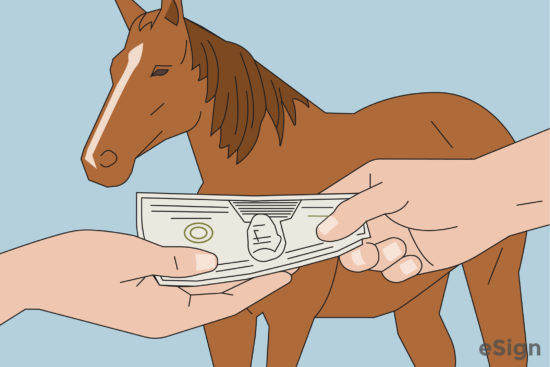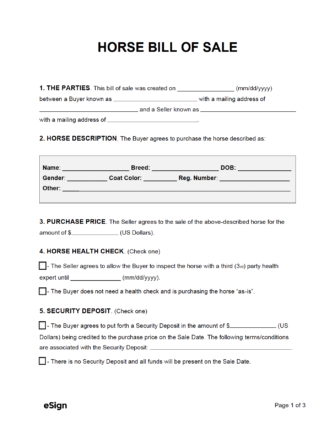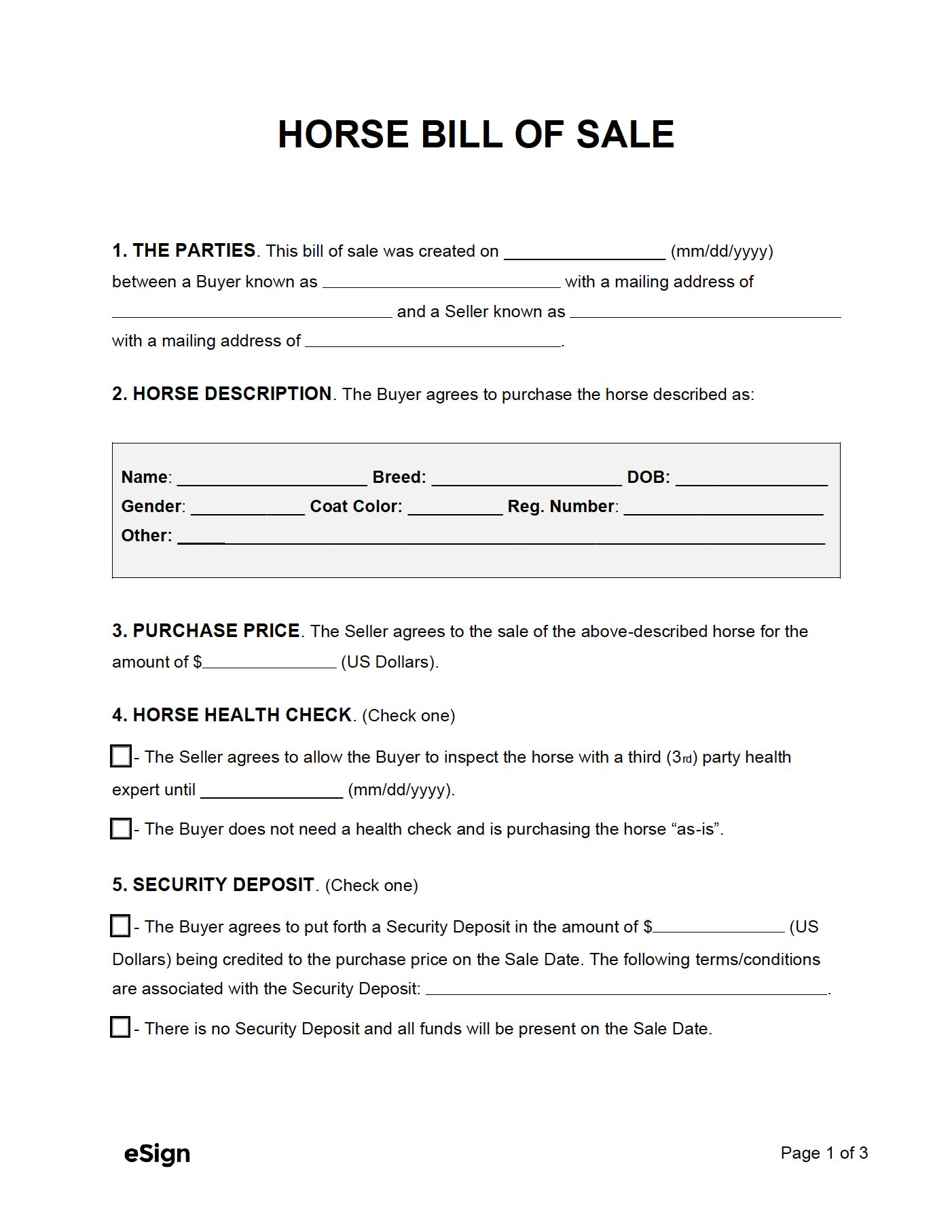Selling a Horse

A horse bill of sale is used anytime a horse’s ownership changes from one person or entity to another. Even if the horse is a gift from one person or another, the recipient will need a completed bill of sale should they intend to sell or gift the horse down the line.
1. Get the Horse Ready
Before listing the horse the owner should take it to the vet to ensure it has all its vaccinations and obtain an overall pre-sale health inspection. Unless done very recently, the horse should also be reshod.
2. Determine the Horse’s Value
Age, bloodline, health, and training all play a role in how the horse is priced. The best way to find the approximate value of the horse is by conducting market research and looking into the sale price of similar horses online or by other means.
3. Photograph the Horse
Quality photos will go a long way in increasing the activity around the listing. For high-value horses, hiring a professional is recommended. The horse should have photographs taken for each gait.
4. Gather Health & Registration Documents
The owner will need to gather anything that shows the history of the horse can improve the selling price, including health records, proof of lineage, and registration forms.
5. Advertise
The owner will need to choose one or more online horse-selling platforms on which to list the horse. Depending on their location, there may be special listings for livestock sales.
In addition to the photos, selling price, and location, the advertisement should include the following information on the horse:
- Name, age, breed, and height
- Show record, awards, achievements, or skills
- Training
- Injuries, illnesses, dietary restrictions, and temperament
6. Speak with Potential Buyers
The seller should respond to inquiries fast and be prepared to answer any and all questions about the horse. It will also be necessary to schedule times for people to come and view the horse in person.
Ideally, the buyer should be asked for references and, if possible, the seller should inspect the site where the horse will be kept to ensure they can care for it.
7. Complete Transaction & Bill of Sale
Once a buyer and the seller have agreed to a price for the horse, payment is preferably made in cash or a bank check to avoid scams.
Upon receiving the payment in full, the seller and buyer can draft and sign the bill of sale.
Sample
EQUINE BILL OF SALE
1. THE PARTIES. This bill of sale was created on [MM/DD/YYYY] between a Buyer known as [BUYER NAME] with a mailing address of [BUYER MAILING ADDRESS] and a Seller known as [SELLER NAME] with a mailing address of [SELLER MAILING ADDRESS].
2. HORSE DESCRIPTION. The Buyer agrees to purchase the horse described as:
Name: [HORSE NAME] Breed: [HORSE BREED] DOB: [MM/DD/YYYY]
Gender: [HORSE GENDER] Coat Color: [HORSE COAT] Reg. Number: [REG. #]
Other: [ENTER ANY NOTES ON THE HORSE HERE]
3. PURCHASE PRICE. The Seller agrees to the sale of the above-described horse for the amount of $[SELLING PRICE].
4. HORSE HEALTH CHECK. The Seller agrees to allow the Buyer to inspect the horse with a third (3rd) party health expert until [MM/DD/YYYY].
5. SECURITY DEPOSIT. The Buyer agrees to put forth a Security Deposit in the amount of $[SECURITY DEPOSIT] being credited to the purchase price on the Sale Date. The following terms/conditions are associated with the Security Deposit: [SECURITY DEPOSIT TERMS & CONDITIONS].
6. OTHER CLAIMS.
The Seller certifies that the horse:
• Is free of any liens, debt, or encumbrances;
• That the Seller is the lawful owner of the horse with the right to sell it.
The Buyer claims that:
• They are purchasing the horse in an “as-is” condition on the Date of Sale with the right of inspecting the horse being waived or satisfied;
• They are aware of the health and safety risks of owning, riding, and caring for the horse;
• They will not hold the Seller liable for any claims after the Date of Sale in reference to the horse.
7. GOVERNING LAW. This agreement shall be bound under the laws in the State of [STATE NAME].
8. SIGNATURES. The buyer and seller agree to the above-described terms and conditions for the horse’s sale/trade/exchange.
Seller Signature: _______________________ Date: [MM/DD/YYYY]
Printed Name: [SELLER NAME]
Buyer Signature: _______________________ Date: [MM/DD/YYYY]
Printed Name: [BUYER NAME]
Witness Signature: _______________________ Date: [MM/DD/YYYY]
Printed Name: [WITNESS NAME]
Witness Signature: _______________________ Date: [MM/DD/YYYY]
Printed Name: [WITNESS NAME]

